Finally, the rainy weather let up long enough for us to get a hike in! First hike of the year, yesterday, was Forgetmenot Ridge in Kananaskis - an unrelenting, uphill grind on a very steep, rough trail, yet still a favourite as it is close by, and, despite (or thanks to) the heart-pounding effort, you do get up there fast!
1) View from a brief rest spot about 1/3 of the way up... Nihahi Ridge in the distance, with the Elbow River in the foreground. The Little Elbow was reasonably tame this time - surprising after all the rain - while the Elbow had many more flowing (shallow) channels than usual - and both as bone-numbingly cold as ever. (NB. There is a bridge a ways further down.... but what fun is that?! ???)
2, 3, 4) And further up, tucked in crevices and between slabs in the exposed limestone cliff face, Saxifraga oppositifolia ooops, that should be bronchialis!
Comments
Re: Ridge walk
Acckk, no, of course not! It's Saxifraga bronchialis. Thanks for bringing me to my senses, Cliff! (Saxifraga oppositifolia does come along later, but don't hold your breath... we missed the bloom as usual!)
Re: Ridge walk
A nice walk, anyway, and much steeper than anything around here!
Re: Ridge walk
Thanks for bringing me to my senses, Cliff! (Saxifraga oppositifolia does come along later, but don't hold your breath... we missed the bloom as usual!)
Please don't ever bring me to my senses, Lori ... the world is in a big enough mess already! ;D ;D
Re: Ridge walk
;D
Perhaps so, from your previous descriptions, Trond? In this area, river level is at about 1600m, and the ridges are at 2200 to 2300m+ elevation. The highest point of Forgetmenot Mountain (a very minor height of land, to be sure, though a very interesting area of conglomerate slabs and boulders), which we did not visit yesterday, is at 2300m+.
1) And continuing along, once most of the climb is over, there is one little band of firs and spruce before gaining the ridge...
And the flowers begin!
2, 3, 4) Silene acaulis in limestone rubble
5) Heading out to the ridge tops... now it is a nice walk, the hard climb is over!
6 - 10) The next sight... the most glorious mounds of alpine potentillas! Potentilla uniflora, I suppose...
We hike here frequently, and every time it is different but equally fascinating - we have never seen the potentillas in such splendour before!
Re: Ridge walk
Brilliant Lori 8)
Re: Ridge walk
Thanks for looking. :)
1) Androsace chamaejasme
2, 3) Campanula uniflora
4) Scenery - turfy areas
5) Oxytropis sericea
6) ... and gravelly stretches
Most abundant were the mat-forming Dryas, the white flowers thickly dotting the scenery photos
7) Dryas octopetala
8 ) And when I took the time to look, I was surprised to find that there are vast tracts of Dryas integrifolia as well, possibly even more abundant
9) Lunch break ahead, behind the band of kruppelholz firs, and out of the very strong wind
10) Willow catkins, in this area where the snow has only recently melted off
Re: Ridge walk
1) Old snow, on this north-facing slope
2, 3) A bank of Phyllodoce glanduliflora behind the kruppelholz
4) Anemone parviflora
5) Zigadenus elegans, very common on the ridges, will not be in bloom for some time yet
6) Same for Castilleja
Back into the rocks...
7) Myosotis alpestris
8 ) I always enjoy seeing this - I think I've figured out what it is - Minuartia austromontana
9) And more gorgeous potentillas!
10) Physaria didymocarpa
Re: Ridge walk
And, despite this being the middle of July, it is a rather late spring up there...
1) Saussurea nuda, as close as we saw to blooming...
2) And another, with a serrated-leaved Rhodiola integrifolia (which is slightly unusual - the leaves are usually entire)
3) And a more normal one...
4, 5, 6) Claytonia megarhiza, always a curiosity to see such succulent foliage amidst the dry, sharp-edged rocks
7, 8, 9) Townsendia parryi(?)... ridiculously-oversized, 5cm-wide flowers on such tiny plants! Charming!
10) And across the edge of the ridge, down the steep south-facing slope, there is respite again from the wind and a rich garden in bloom!
Re: Ridge walk
On the warm, south-facing slope, there are a few different plants than on the ridge...
1) Pulsatilla patens grow here and are mostly in seed.... the odd one is still in bloom
2, 3) Polemonium pulcherrimum
4) Phacelia sericea
5) Sedum lanceolatum
6) The purple patches on the slope are Delphinium bicolor, which are up to about 15cm tall here. (These also occur on the ridge, where they are a bit shorter yet.)
7) Anemone multifida
Re: Ridge walk
Wow, great series Lori... you've been having some fun! Some very choice plants there, but I am most taken with Campanula uniflora... this dang thing does a pretty good imitation of a gentian, doesn't it? Such a choice and rarely seen campanula, are you able to grow it in your garden? I see that you're not sure about the Potentilla ID (Potentilla uniflora), are there many Potentilla in the area that make the identification difficult? Regardless, it is a very fine Potentilla, probably one of the better rock-garden worthy ones. Here again, can you grow it in your garden, and if so, does it remain compact and floriferous as your photos show.
It is so refreshing to see, and to read, about cool air, cold winds, snow patches, when it is blazing hot here... supposed to be 95 F tomorrow, yet another day in the 90s. The scenery views remind me of some of my travels in Wyoming and Montana... endless skies and expansive vistas. Thanks for posting all of this.
Re: Ridge walk
Magnificent hike, Lori ... we are off to the Dolomites today ... hope we see plants as pristine as these. Many thanks for posting.
Re: Ridge walk
You're welcome, Mark and Cliff!
Wow, Cliff, hope you have a fabulous time in the Dolomites!
Campanula uniflora... are you able to grow it in your garden?
I don't know - I've never tried. I wonder if other Calgary-area alpine enthusiasts are growing it?
I see that you're not sure about the Potentilla ID (Potentilla uniflora), are there many Potentilla in the area that make the identification difficult? Here again, can you grow it in your garden, and if so, does it remain compact and floriferous as your photos show.
According to Moss & Packer's Flora of Alberta, there are 6 potentilla species that are: 1) alpine, and recorded in this area; 2) small (5 species up to 15cm, and 1 additional species 10 - 30cm); and 3) with trifoliate leaves (4 species strictly trifoliate, and 2 additional species with 3-5 leaflets - I suppose I could discount those 2). Potentilla uniflora seems likely, but I haven't plowed through all the distinguishing characteristics, so I'm not entirely sure. Re. garden-worthiness, I don't know that either. I'm sure there are local alpine gardeners who do know both the ID and the answer to the last question... if only they could be coaxed into posting here. ;)
Continuing...
1, 2) On the warm slope, the Castilleja are much more advanced than on the ridge
3) Contouring our way around the bend, there is another north-facing area where the snow has just left...
4 - 6) And the Salix have just come into bloom
7) As have a little army of tiny Dodecatheon
8 ) More snowmelt bloomers, Ranunculus eschscholtzii
9) And Ranunculus pygmaeus
10) And Cassiope tetragona
Re: Ridge walk
I am very jealous on your ridge walk, Lori! I recognize some of the plants from mountains in Norway but the majority are unfamiliar. Such rich areas are not in the vicinity for me. We have high mountains (the highest are well above 2000m) and we have rich flora many places, but due to the ice age the flora of Norway has been decimated a lot. The bedrock is mostly hard sandstone, granite or gneiss, not the best for showy plants.
Campanula uniflora exists in the highest mountains here but I have never seen it live.
Does Dryas octopetala and D. integrifolia grow intermingled? Don't they have different habitats?
Re: Ridge walk
Dryas octopetala and D. integrifolia grow in the same habitat - alpine slopes - and in the same elevations and areas here. They hybridize, also.
We usually see D. drummondii at lower elevations - for example, forming huge mats on the stabilized gravel bars on the river floodplain at this location, and along gravelly road cuts elsewhere. Roads into the higher elevations can bring D. drummondii into contact with the white-flowered ones, oddly enough (so I've noted).
I'll wrap this up tomorrow. Good night!
Re: Ridge walk
A fantastic array of photographic candy.
Thanks, Lori!
Re: Ridge walk
Dryas octopetala and D. integrifolia grow in the same habitat - alpine slopes - and in the same elevations and areas here. They hybridize, also.
We usually see D. drummondii at lower elevations - for example, forming huge mats on the stabilized gravel bars on the river floodplain at this location, and along gravelly road cuts elsewhere. Roads into the higher elevations can bring D. drummondii into contact with the white-flowered ones, oddly enough (so I've noted).I'll wrap this up tomorrow. Good night!
Thanks.
Good night? You mean Good Morning! Here it is a nice sunny (some clouds) quiet morning. Not a leaf is disturbed by air movements other than that I make when moving!
Re: Ridge walk
For those who have the endurance to finish this photo marathon... ;D
1 - 2) I'm puzzled by this one... Erigeron grandiflorus? From googling... it seems that petal width can vary quite a bit in this species (or among formerly distinct plants that have been lumped into this species). The non-leafy stems and the furry involucre make me think Erigeron...
3, 4) Leptarrhena pyrolifolia Saxifraga occidentalis
5) Oxytropis podocarpa, with its feathery foliage... the flowers will soon change to showy, red, inflated seedpods
6) Silene uralensis... the leafiest, burliest one I've seen!
7) Smelowskia calycina
8) A beautiful, if austere, little garden of brilliant Rhodiola integrifolia, Smelowskia and tiny ferns
9) Potentilla ssp.... very common on the ridge... Yeah, I'm not sure what this one is either!
10) Eriogonum ovalifolium, coming out of winter... the next time I show these, they will be beautifully filled-out and in bloom
Re: Ridge walk
And, finishing up with the absolute stars of this hike (again)...
1) Dryas integrifolia
2) Dryas octopetala
3) And, just for completeness and comparison, from down at river level, Dryas drummondii.
Re: Ridge walk
Great stuff Lori! Leptarrhena pyrolifolia is a cutie. Your photos caused me to plunge headlong into a google search on Erigeron grandiflorus. After doing some research, I feel more confused about it than when I started! I include some links. From what I can tell, the species is almost always described as lavender or blue, and only in the Flora of North America is there mention that the flowers are "rarely white". The species name has also consumed E. simplex, so depending on one's inclination, this is a northern species from Alaska down through "to the summit of the Rocky Mountains", or it includes other taxon thereby extending the range all the way to Mexico. It is also related or conspecific with a couple Russian taxon.
When I look at those photos, particularly the flowers, it looks more like an arctic Chrysanthemum or Leucanthemum to me, reminiscent of L. integrifolium, although that simple-leaf species is way out of your range. Do you ever find lavender forms of this, or always white? It is very pretty whatever it is, most likely an Erigeron, and probably grandiflorus as you have it, but it seems the taxonomy is definitely a muddle-puzzle ;D
Erigeron grandiflorus (Synonym: Erigeron simplex)
http://www.google.com/imgres?imgurl=http://www.swcoloradowildflowers.com...
Erigeron grandiforus (fro, Flora of the Canadian Arctic Archipelago). 2 species described, skip by Erigeron compositus ssp. arcticus)
http://www.google.com/imgres?imgurl=http://www.mun.ca/biology/delta/arct...
USDA page:
http://plants.usda.gov/java/profile?symbol=ERGR3
in Flora of North America:
http://www.efloras.org/florataxon.aspx?flora_id=1&taxon_id=250066607
Re: Ridge walk
Curious about where Kananaskis, near Calgary, Alberta Canada is, I was playing around with Google Maps, one of my favorite pastimes. Googled the area, turn on Terrain to get a 3D sense of where you are... fun to explore. Google Maps is great, but doesn't label many point of interest, such as the various peaks, and for some reason, rarely labels rivers and bodies of water (why not?). So, in the Kananaskis area, I can see various mountain ridges, but they're unlabeled; Lori, can you indicate which is Forgetmenot Ridge, or indicate the path you hiked. Panning around on Google Maps, I see other amusingly named mountains; Mt. Turbulent, Mt. Inflexible :D
Not sure on which side of Kananaskis your hike was, but I think the terrain map I show here (just to show what these 3D terrian maps look like) is the wrong side, north of where you were hiking. After making the first 2 screen captures, I found Nihahi Ridge (red X marks the spot in the third map), so if you could see that, Forgetmenot Ridge must not be too far to the north of Nihahi Ridge.
Re: Ridge walk
... Mt. Indefatigable, Disappointment Ridge, etc..
You've pretty much got it there with your last screen capture, Mark. I was going to attach a piece of a topo map, with my guess as to the route... contour interval = 25m... but I can't get the file down small enough to attach.
EDIT: Okay, I think I figured it out - see attachment.
If you look at this site, the third photo also marks the route on a 3-D topographic view.
http://hikealberta.com/hike/forgetmenot-ridge
The "end" of that route, in red, is just one of many options... we usually continue SE along the ridge, which is much more interesting, out toward and onto Forgetmenot Mountain. Of course, once you're up there, you can go any which way you want - the ridge has several fingers to be explored.
Re: Ridge walk
Cool! I used the link you suggested, which has a Google earth KMZ file; if one has the free Google Earth Plugin in their web browser, it'll launch Google to that bookmarked location. Then one can zoom in and out, and "orbit" in any direction and elevation. I saved off three views, the second and third views are lower in the horizon, to get a better sense of the mountain relief, the last view looking in the opposite direction towards the valley floor.
Re: Ridge walk
I have to wait till I get home to amuse myself with this. Haven't enough bandwidth with my cellphone.
Re: Ridge walk
That's very neat, Mark!
Re: Ridge walk
For those who have the endurance to finish this photo marathon... ;D
1 - 2) I'm puzzled by this one... Erigeron grandiflorus? From googling... it seems that petal width can vary quite a bit in this species (or among formerly distinct plants that have been lumped into this species). The non-leafy stems and the furry involucre make me think Erigeron...
3, 4) Leptarrhena pyrolifolia
5) Oxytropis podocarpa, with its feathery foliage... the flowers will soon change to showy, red, inflated seedpods
6) Silene uralensis... the leafiest, burliest one I've seen!
7) Smelowskia calycina
8) A beautiful, if austere, little garden of brilliant Rhodiola integrifolia, Smelowskia and tiny ferns
9) Potentilla ssp.... very common on the ridge... Yeah, I'm not sure what this one is either!
10) Eriogonum ovalifolium, coming out of winter... the next time I show these, they will be beautifully filled-out and in bloom
Lori, the pictures are wonderful. Is the Silene uralensis the same as Silene/Lychnis apetala? I've seen it both ways and never knew which was correct. This little plant is one of my favorites in Colorado - found high up in the Mosquito Range and not very plentiful. Do you grow this one? Is it rare in your area? The Dryas pictures are superb.
Re: Ridge walk
6) Silene uralensis... the leafiest, burliest one I've seen!
Lori, the pictures are wonderful. Is the Silene uralensis the same as Silene/Lychnis apetala? I've seen it both ways and never knew which was correct. This little plant is one of my favorites in Colorado - found high up in the Mosquito Range and not very plentiful. Do you grow this one? Is it rare in your area? The Dryas pictures are superb.
Anne, Lori and I did some sleuthing on the confusing nomenclature of Silene uralensis here :D:
http://nargs.org/smf/index.php?topic=79.msg554#msg554
Re: Ridge walk
Lori and Mark, whaat a pair of sleuths! Unfortunately, I'm still a bit confused. The pictures certainly look like the plant I saw twice (Mt. Monroe, Colorado, close to 13,000'). I thought it was a charmer but the weather was terrible and the slide was poor. It was the only plant I found and I looked for others for some time. So I'll look for seed of all the names mentioned. One of them must be the right one. Many thanks for all the information.
Re: Ridge walk
According to my main local reference (albeit from 1992), Lychnis apetala was renamed to Silene uralensis, so, yes, apparently the same plant.
No, I don't grow it. Perhaps others around here do? I would say it is uncommon, perhaps, in the habitat it favours here, which seems to be scree slopes.
Re: Ridge walk - an update, 20 days later
We took another stiff jaunt up Forgetmenot Ridge on August 4th, 20 days later, to see the progress of bloom.
1) Approaching on the highway, the summit is not what appears to be the highest point in the photo, but is instead, one of the lower points, just to the left of center.
2, 3) After the creek crossings, the gravel river bank where we put on our boots is thickly vegetated with Dryas drummondii, now mostly with uniformly clockwise-twisted seedheads (prior to opening in puffs to release the seeds), and with Oxytropis monticola in bloom.
4, 5) The way up...
6) Abundant Zigadenus elegans on a little bench near treeline
7) And the vista of flowers on the ridge.
Re: Ridge walk
Amazing vistas and plants, Lori ... many thanks for posting.
Re: Ridge walk - update, 20 days later
You're welcome, Cliff.
A few more:
1) Rumex acetosa ssp. alpina, adding a touch of russet to the landscape
2, 3) Saussurea nuda is now in bloom up there - though it seems all is a week or 10 days behind last year's bloom; the usual purple-flowered form, and an odd pink one
4, 5) Polygonum viviparum - as I learned on the SRGC forum, the bulbils(?)/nutlets on the lower part of the inflorescence are edible, though they are not very flavourful in a raw state
6) Minuartia obtusiloba
7) Hedysarum boreale var. mackenzii is still providing much colour, among the white-flowered Hedysarum sulphurescens
8, 9) Loments forming on some of the earlier-blooming Hedysarum boreale var. mackenzii, and an odd one with white flowers
10) There are nicely-dwarfed forms of Dasiphora fruticosa everywhere up here
Re: Ridge walk
My understanding is that the former Potentilla fruticosa has been cleaved off from that genus, as it is the only(?) one that is woody, rather than herbaceous. I'm sure someone else who is more knowledgeable can expound on or correct this, though. ???
Yes, the loments do help me out in moments of doubt... though, really, the inflorescence form is pretty distinctive too, among the plants that occur here.
Re: Ridge walk
1) Potentilla uniflora(?) that was in its glory 20 days ago, has now largely finished blooming. (I know this photo looks as though it is sideways, but it isn't - the plants are growing down a steep slope!)
2, 3) And Eriogonum ovalifolium var. ovalifolium androsaceum has begun to bloom, some with colourful buds and flowers
4) It's now clear that some of the Androsace chamaejasme have been fertilized, as they have turned from white to rosy tones.
5) A tiny Gentiana prostrata...
6) How tiny?
7) Silene uralensis ssp. attenuata, with upright capsule full of seeds
8, 9) Zigadenus elegans, now in bloom everywhere on the ridge... very attractive to small black flies, oddly enough... almost every flower has its own fly, or vice versa.
10) A view
Re: Ridge walk
Beautiful plants, Lori, specially the Silene uralensis. Do you see much of that? The only place I've seen it was in the Mosquito Range in Colorado and it always seemed to be a rare find. Sometimes when you see a plant you see others in the vicinity - that never seemed to be the case with Silene uralensis. Loved the Gentiana prostrata.
Re: Ridge walk
Well, the more I think about it, Silene uralensis is probably a little more abundant than I first would have said... It is not a plant that is very noticeable while walking - one has to stop and peer around closely to find it! Having done so, though, there are often 3-4 plants in the same vicinity of scree. "Uncommon" is still probably not too inaccurate a description, I suppose.
Re: Ridge walk
A few species that were new to me, on this trip:
1, 2) Packera contermina (formerly Senecio conterminus)... distinctive fleshy, slightly angular basal foliage
3) Artemisia michauxiana
4) Erigeron caespitosus
And some others...
5) Delphinium glaucum, which becomes increasingly dwarfed with elevation and exposure, from 5' plants at river level to <1' tall ones up top
6) Tiny Delphinium bicolor
7) Salix reticulata with Silene acaulis
And heading down...
8, 9) This young bighorn ram (Ovis canadensis) was feeding along the slope off the ridge, and very politely moved about 50' upslope to let us pass on the trail below.
Re: Ridge walk
This is a trail that takes as much concentration going down, as coming up, but a slightly more level bit in the spruce woods allows a brief look around (before the really steep part!)...
1, 2) Lichen, mosses, mushrooms on the cool forest floor
3) Where the trail levels out again, a good crop here of buffalo-berry/soapberry (Sheperdia canadensis) - good news for the bears, I hope
4) Castilleja in the aspen forest lowlands
5) Gentiana affinis in the river floodplain
6) And a final view, from the floodplain.
Re: Ridge walk
WOW! I'm speechless! You have shown many plants here that I have never seen in all my travels out west...I need to hire you as a guide the next time I'm out. Sooo many spectacular plants!
Re: Ridge walk
Thanks! It's my pleasure to show them!
Re. guiding... I "work" for pretty cheap... a sandwich and a litre of water is my going rate. :D :D
Re: Ridge walk
Then I will join the party, Todd, and Lori, I can bring the water if Todd take care of the sandwich.
My favorites this time were the two Delphiniums. They are so dinky compared to the "tyrihjelm" (Aconitum septentrionale) that grows here.
Re: Ridge walk (Forgetmenot Ridge, Kananaskis P. P., Alberta)
Can anyone stand yet another update?
We got some more exercise here again on August 23, after some rain and northerly winds cleared the air of thick smoke that had been casting a pall for a few days last week. (The smoke was from about 300 forest fires burning in British Columbia, and it affected air quality through Saskatchewan, and even as far east as northern Ontario!)
1) Coral fungi, Ramaria sp.(?), in the last band of conifers.
2, 3, 4, 5) On the ridge, Eriogonum ovalifolium var. ovalifolium androsaceum was one of the most prominent plants in bloom, showing colour variations from cream to apricot and rose.
6) The wind was strong (again) and positively arctic up there... we hauled out the big fleece jackets, pants, hats and gloves!
7) Delphinium glaucum still providing colour.
8 ) A bad, fuzzy pic of Gentiana amarella (guess I could blame the wind! ;)), which was blooming in large number.
9) Townsendia parryi, some in bloom, some in seed.
10) Alpine grasses... must figure these out some day too.
Re: Ridge walk (Forgetmenot Ridge, Kananaskis P. P., Alberta)
1) Sparse alpine form of Campanula rotundifolia (which contrasts greatly with the robust foothill plants, that form dense blue cylinders of flowers)
Down the warm south-facing slope, and in the swales between rocky ridges, a more prairie-like assemblage...
2, 3, 4) Gaillardia aristata, with colourful yellow rattle (Rhinanthus minor); a very orangey group...
5) Solidago multiradiata
6, 7, 8 ) The colour variations of Eriogonum umbellatum var. subalpinum
9) Still a lot of bloom, now provided by Agoseris glauca, yarrow, bedstraw, asters, etc.
10) Castilleja rhexifolia
Re: Ridge walk (Forgetmenot Ridge, Kananaskis P. P., Alberta)
Are you out walking every afternoon and weekend, Lori? The diversity of plants is amazing!
Re: Ridge walk (Forgetmenot Ridge, Kananaskis P. P., Alberta)
Lori, this thread, as with your other posts, is a joy to explore. As Trond says, the sheer diversity of plants is an
education to see. Thanks for sharing.
As Mark McD. points out elsewhere, you have now been introduced to a wider audiece in the latest IRG- #8- August 2010..... http://www.srgc.org.uk/logs/index.php?log=international
..........it really is a treat to be able to put a face to these great posts! 8)
Re: Ridge walk (Forgetmenot Ridge, Kananaskis P. P., Alberta)
Well, thank you for looking and for the comments!
Are you out walking every afternoon and weekend, Lori?
Gee, that would be nice! This year, and last, I finally decided to take as much vacation as possible through the summer (when it counts, in this very short season!) and we have tried to put it to good effect as far as hiking has gone this year. It's great to be able to get out during the week, and avoid the weekend road traffic. Strangely, the weather has not cooperated as well as usual though - the pattern lately has been 2-3 clear days, alternating with cloud and rain (whereas we usually get uninterrupted weeks of "bluebird" days through the summer - cloudless blue skies, that is).
Thank you very much for the very nice introduction in the latest IRG, Maggi. Kudos for your success at producing yet another immensely absorbing journal!
Re: Ridge walk (Forgetmenot Ridge, Kananaskis P. P., Alberta)
This year, and last, I finally decided to me to take as much vacation as possible through the summer (when it counts, in this very short season!) and we have tried to put it to good effect as far as hiking has gone this year. It's great to be able to get out during the week, and avoid the weekend road traffic. Strangely, the weather has not cooperated as well as usual though - the pattern lately has been 2-3 clear days, alternating with cloud and rain (whereas we usually get uninterrupted weeks of "bluebird" days through the summer - cloudless blue skies, that is).
The weather cooperated? That never happens here! And 2-3 weeks of "bluebird" as you call it - Utopia that is.
What you describe is a regular Norwegian summer!

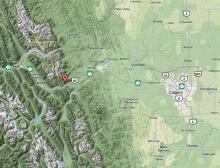
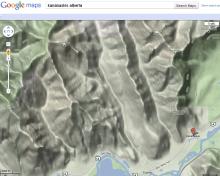
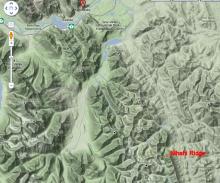
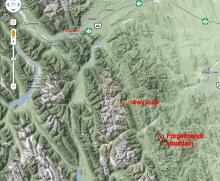
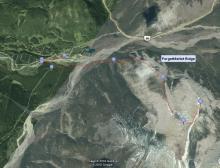
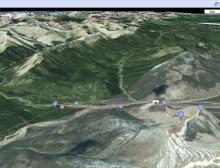
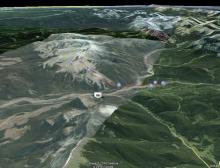
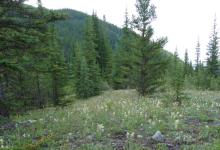
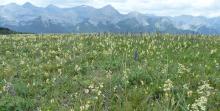

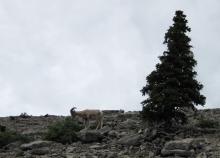
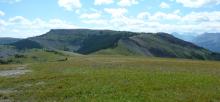
Sorry, Lori ... certainly not Saxifraga oppositifolia!